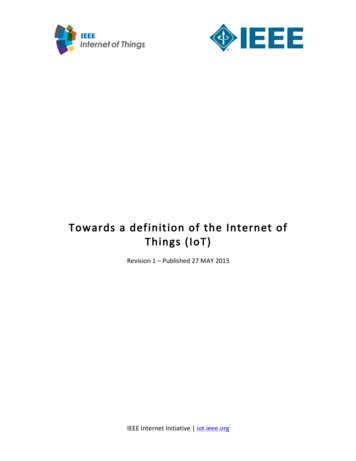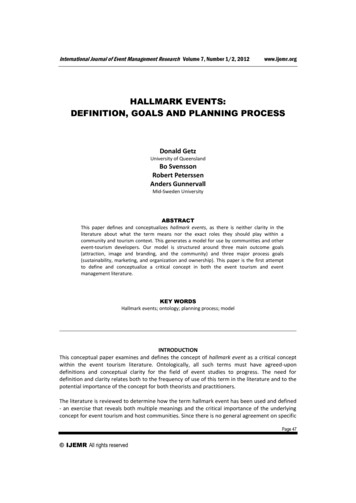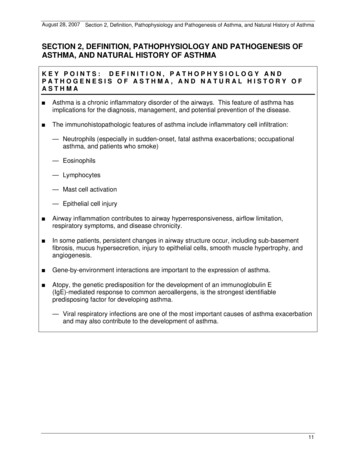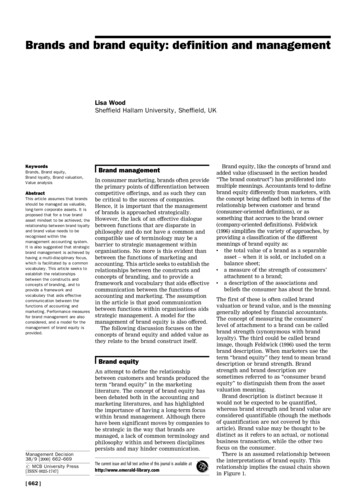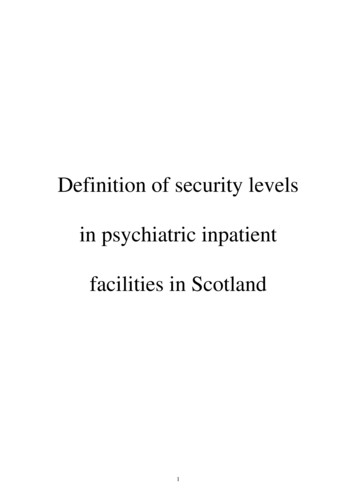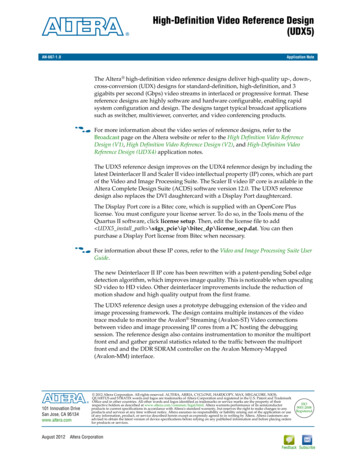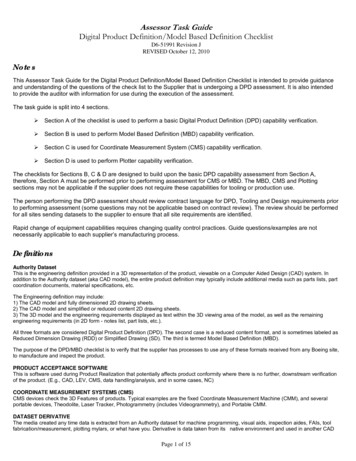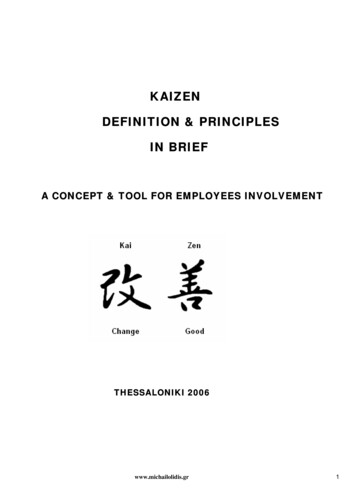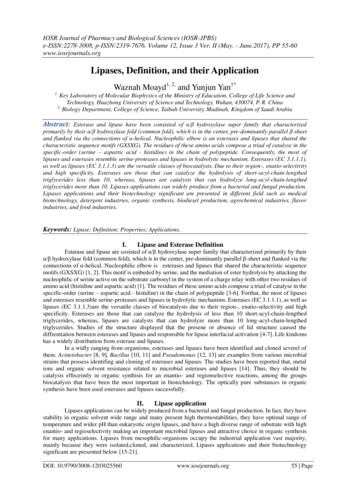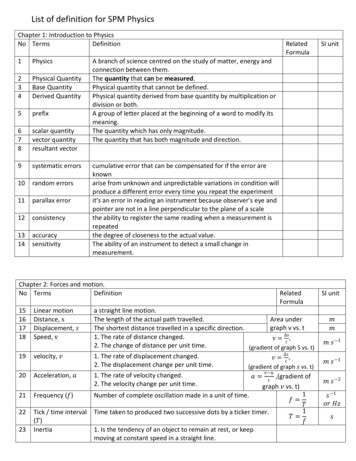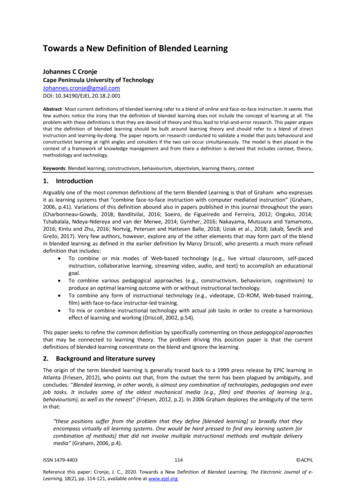
Transcription
Towards a New Definition of Blended LearningJohannes C CronjeCape Peninsula University of TechnologyJohannes.cronje@gmail.comDOI: 10.34190/EJEL.20.18.2.001Abstract: Most current definitions of blended learning refer to a blend of online and face-to-face instruction. It seems thatfew authors notice the irony that the definition of blended learning does not include the concept of learning at all. Theproblem with these definitions is that they are devoid of theory and thus lead to trial-and-error research. This paper arguesthat the definition of blended learning should be built around learning theory and should refer to a blend of d irectinstruction and learning-by-doing. The paper reports on research conducted to validate a model that puts behavioural andconstructivist learning at right angles and considers if the two can occur simultaneously. The model is then placed in thecontext of a framework of knowledge management and from there a definition is derived that includes context, theory,methodology and technology.Keywords: Blended learning; constructivism, behaviourism, objectivism, learning theory, context1.IntroductionArguably one of the most common definitions of the term Blended Learning is that of Graham who expressesit as learning systems that “combine face-to-face instruction with computer mediated instruction” (Graham,2006, p.41). Variations of this definition abound also in papers published in this journal throughout the years(Charbonneau-Gowdy, 2018; Banditvilai, 2016; Soeiro, de Figueiredo and Ferreira, 2012; Onguko, 2014;Tshabalala, Ndeya-Ndereya and van der Merwe, 2014; Gynther, 2016; Nakayama, Mutsuura and Yamamoto,2016; Kintu and Zhu, 2016; Nortvig, Petersen and Hattesen Balle, 2018; Uziak et al., 2018; Jakab, Ševčík andGrežo, 2017). Very few authors, however, explore any of the other elements that may form part of the blendin blended learning as defined in the earlier definition by Marcy Driscoll, who presents a much more refineddefinition that includes: To combine or mix modes of Web-based technology (e.g., live virtual classroom, self-pacedinstruction, collaborative learning, streaming video, audio, and text) to accomplish an educationalgoal. To combine various pedagogical approaches (e.g., constructivism, behaviorism, cognitivism) toproduce an optimal learning outcome with or without instructional technology. To combine any form of instructional technology (e.g., videotape, CD-ROM, Web-based training,film) with face-to-face instructor-led training. To mix or combine instructional technology with actual job tasks in order to create a harmoniouseffect of learning and working (Driscoll, 2002, p.54).This paper seeks to refine the common definition by specifically commenting on those pedagogical approachesthat may be connected to learning theory. The problem driving this position paper is that the currentdefinitions of blended learning concentrate on the blend and ignore the learning.2.Background and literature surveyThe origin of the term blended learning is generally traced back to a 1999 press release by EPIC learning inAtlanta (Friesen, 2012), who points out that, from the outset the term has been plagued by ambiguity, andconcludes: “Blended learning, in other words, is almost any combination of technologies, pedagogies and evenjob tasks. It includes some of the oldest mechanical media (e.g., film) and theories of learning (e.g.,behaviourism), as well as the newest” (Friesen, 2012, p.2). In 2006 Graham deplores the ambiguity of the termin that:“these positions suffer from the problem that they define [blended learning] so broadly that theyencompass virtually all learning systems. One would be hard pressed to find any learning system [orcombination of methods] that did not involve multiple instructional methods and multiple deliverymedia” (Graham, 2006, p.4).ISSN 1479-4403114 ACPILReference this paper: Cronje, J. C., 2020. Towards a New Definition of Blended Learning. The Electronic Journal of eLearning, 18(2), pp. 114-121, available online at www.ejel.org
Johannes C CronjeAfter an extensive analysis of the various definitions of the term Friesen proposes that “Blended learning’designates the range of possibilities presented by combining Internet and digital media with establishedclassroom forms that require the physical co‐presence of teacher and students” (Friesen, 2012, p.1).2.1 The missing ingredientThe problem with Friesen’s definition, however, is that it still does not acknowledge learning, unlike adefinition in a previous issue of this journal which does, as it points out that: “The concept of blended learningis derived from two words, blend and learning. The word blend means combining things and learning denotesan assimilation of new knowledge” (Tshabalala, Ndeya-Ndereya and van der Merwe, 2014, pp.102–103).The definitions of blended learning provided in this journal by authors who use the term in the titles of theirwork are equally diffuse. Table 1 provides an overview of definitions provided by such authors in the periodfrom 2012 to 2018. The table has been arranged in order of pedagogical complexity, from no definitionthrough technology-driven definitions, to pedagogical and strategic definitions.Table 1 shows that a literature survey conducted in 2018 indicates that there still is very little consensus as to auniversal definition of the term Blended learning (Nortvig, Petersen and Hattesen Balle, 2018). Another author(Charbonneau-Gowdy, 2018) simply refers to examples of what she considers to be blended learning. Sherequires the reader to develop an understanding of how she uses the term from a description of the projectdiscussed in the article. The majority of authors rely on the classic combination of face-to-face and technologyto frame their definitions, although there seems to be a taxonomy of complexity ranging from a simplestatement of technologies to an acknowledgement of teaching and learning, context, pedagogy and finallyvalue (Uziak et al., 2018; Nakayama, Mutsuura and Yamamoto, 2016; Kintu and Zhu, 2016; Onguko, 2014;Gynther, 2016). Some authors extend the metaphor of the blend to that of a recipe, by referring toingredients and method(Banditvilai, 2016; Tshabalala, Ndeya-Ndereya and van der Merwe, 2014). Only onearticle goes as far as seeing blended learning as a strategy, although, ironically these authors do not provide adefinition for blended learning at all (Soeiro, de Figueiredo and Ferreira, 2012).From the analysis of articles in past issues of this journal it can be seen then that there is no clear definition ofblended learning that places the focus on learning. What does become clear though is that, in their writing, theauthors of these papers are fully aware that the complexities of blended learning go far beyond decidingbetween face-to-face and technology-mediated contact.In considering the relationship between the blend and the learning, or the “combining of things ( and the)assimilation of knowledge” (Tshabalala, Ndeya-Ndereya and van der Merwe, 2014, p.102) it is necessary toconsider two of the key arguments in our field – (1) the so-called “Clark-Kozma debate” (Clark, 1994; Kozma,1994) and (2) the No significant difference phenomenon (Russell, 1999). Richard E Clark (1994) has arguedsince 1983 that the medium of instruction does not influence the quality of learning. He uses the now famousgrocery truck analogy saying that the medium of instruction will no more influence the quality of learning thana delivery truck would influence the nutritional value of the food it delivers. Kozma (1994) however argues thatcertain affordances of technology may well enable forms of learning that others do not – in other words, youcannot drive a grocery truck to the moon. Tom Russell, in support of Clark, presents a bibliography of 355academic works that indicate no significant differences (NSD) in student outcomes between various modes ofdelivering education (Russell, 1999).Along these lines some authors argue that “despite the failure of some variables to show as significant factorsto blended learning outcomes, learners showed a high affinity to engage in blended learning; which accountsfor learner attitudes being contributors to learner satisfaction and intrinsic motivation” (Kintu and Zhu, 2016,p.192). Others draw specific attention to the affective domain. In a passionate conclusion Soeiro, de Figueiredoand Ferreira argue that “beyond what is often described as the coldness of technology, educators andstudents can help each other find technology-supported contexts that never existed and where people canlearn (together) to listen with their hearts” (2012, p.348).www.ejel.org115ISSN 1479-4403
The Electronic Journal of e-Learning Volume 18 Issue 2 2020Table 1: Definitions of 'Blended learning' in EJEL articlesCategoryNo definitionDefinition“there has not been completeagreement among researchers aboutthe precise definition or meaning of theterm ‘blended learning’”Author(Nortvig, Petersen andHattesen Balle, 2018,p.47)CommentAuthors conducted a literaturesurvey based on a search for “elearning” OR “online learning” OR“blended learning” OR “hybridlearning” and concluded that noclear definition existed.Hybrid“Massive Open Online Courseware(MOOC’s) or their hybrids, so-calledBlended Learning Programs”(Charbonneau-Gowdy,2018, p.56)Author uses MOOC as an exampleof what she means by BlendedLearning and provides no formaldefinition.Face-to-faceandtechnology“ platforms are also used for deliveryand tracking of blended learning, i.e. acombination of traditional (face-to-face)and on-line resources”“ blended learning, which consists offace-to-face sessions and learningmaterials that are supported byinformation communication technologies(ICT)”“The design in this study involves atransition from traditional face-to-faceteaching-learning to blended learningwith technology”“In this paper, blended learning isdefined as a deliberate combination ofself-directed study of offline contentdeployed on tablets, with occasionalface-to-face meetings, moderatedthrough instructor-led sessions. Thisdefinition takes into considerationaccess to offline professionaldevelopment (PD) content on tabletscombined with teachers’ face-to-faceinteractions with their peers andinstructors referred to as professionaldevelopment tutors (PDTs). JiFUNzeniblended learning approach emphasizesthe use of appropriate technologies foreach context based on the contextualrealities”.“Blended learning courses integrateonline with face-to-face instruction in aplanned, pedagogically valuablemanner, and do not just combine buttrade-off face-to-face with online activity(or vice versa)” (Vignare, 2007, p.38).(Uziak et al., 2018, p.1)(Nakayama, Mutsuuraand Yamamoto, 2016,p.43)These two authors use the mostbasic definition that relies simply onthe dimensions of contact andtechnology to deliver (and track)learning materials. No mention ismade of the actual learning thatmay occur.(Kintu and Zhu, 2016,p.181)These authors include the termsteaching and learning.(Onguko, 2014, p.78)In addition to a clear description ofwhat was done this author adds thedimensions of appropriateness andcontext.(Gynther, 2016, p.21)This author recognises pedagogyand value.“The article underscores the conceptthat many “ingredients” can comprise ablended learning model, includinginstructor-delivered content, e-learning,webinars, conference calls, live or onlinesessions with instructors, and othermedia and events, for example,Facebook, e-mail, chat rooms, blogs,podcasting, Twitter, YouTube, Skypeand web boards”“the mixture of traditional deliveryincluding: lectures, group discussions,apprenticeships and experientiallearning, together with e-learningmethods, which accommodate variouslearning needs of a diverse audience ina variety of subjects”(Banditvilai, 2016,p.223)These authors list methods ofdelivery as well as platforms usedfor such delivery, much as a recipewould have “ingredients” and amethod.“ we were exploring pedagogicalparticipatory strategies, personal andcollaborative, in a blended- learningenvironment supported by Moodle”(Soeiro, de Figueiredoand Ferreira, ala, NdeyaNdereya and van derMerwe, 2014, pp.102–103)116Although these authors do notprovide a clear definition of blendedlearning they refer to pedagogy aswell as strategy. ACPIL
Johannes C CronjeMore comprehensively though authors argue for a sensitivity to the context in which learning takes place:“thus in a context where there is lack of access to electricity, Internet is not guaranteed, and schools lack basicamenities including clean and safe learning spaces, learning materials such as textbooks and facilities such asdesks, blended learning must be redefined with consideration of the contextual realities” (Onguko, 2014,p.78). In some contexts it could even be argued that technological solutions are better than face-to-face: “onthe other hand, it illustrates how deaf students who do not want to expose themselves can benefit from theexperience of community learning afforded by pedagogical strategies and tools that could never exist face-toface” (Soeiro, de Figueiredo and Ferreira, 2012, p.347).If there is to be no significant difference in learner performance, regardless of the mode of delivery then itholds that, in developing blended learning alternatives one should look rather at the theoretical underpinningsof teaching and learning than at the delivery mechanisms. One could therefore argue that a definition ofblended learning needs not be too specific in defining exactly what delivery medium is used. It is the context,rather than the meaning, that makes a difference. A definition of blended learning should focus on learning.2.2 Two dimensions of learningOver time behaviourism and constructivism have evolved as two major, opposing dimensions of learning(Lowrey, 2013). The binary opposing nature of the two paradigms has been outlined by many authors,including Cronje (2006, p.390).Figure 1: Contrasting views of Objectivism and Constructivism (Cronje, 2006, p.390)The view of behaviourism/objectivism and constructivism as opposites was particularly strong in the 1990s.There were various calls for a move towards constructivism (Jonassen, 1991; Davis et al., 1993). More recentlythese two “opposing” dimensions have been researched specifically as they contribute both to face-to-faceand online learning (Weegar and Pacis, 2012). It has been shown that, while early computer-based trainingprogrammes were primarily behaviourist in their design, “the use of technology in online courses has slowlyshifted the theoretical balance from behaviorism to constructivism due to the increased use of educationaltechnologies” (Weegar and Pacis, 2012, p.17).More recently there is an increased call for the integration of behaviourist and constructivist principles (Elen,2017). The problem with a model of linear opposition between the two paradigms is that, as the one goes up,the other goes down. If the balance is shifting from the one to the other then, at some stage, there will be aposition that is neither behaviourist nor constructivist. Nevertheless it is argued that “often instructors arewww.ejel.org117ISSN 1479-4403
The Electronic Journal of e-Learning Volume 18 Issue 2 2020choosing to utilize a combination of these two learning styles in an effort to best meet the learning styles forall students” (Weegar and Pacis, 2012, p.17).To overcome this problem of a false dichotomy Cronje (2006) proposed a two-by-two matrix plotting the twoextremes at right angles as shown in Figure 2. The resultant matrix contains four quadrants, construction,which is high in constructivist and low in behaviourist/objectivist elements, injection which is high inbehaviourism but low in constructivism, where the “combination of these two learning styles” (Weegar andPacis, 2012, p.17) is highest, and the immersion quadrant, which is low in overt evidence of either, and where“it is safe to conclude that the majority of our learning occurs informally” (Shipley, 2017, p.118).Figure 2: The integration of two learning paradigms (Cronje, 2006, p.392)The model has subsequently been tested by Elander, (2012) who found that it was indeed possible to identifycourses that were high in both behaviourist and constructivist elements, as is shown in Figure 3. Elanderdemonstrated that the majority of instructional designers worked mainly in an objectivist/behaviouristparadigm, but that there were substantially more designers who took an integrated, and therefore blendedapproach, than those who worked in the immersion or construction quadrants only.Figure 3: Four quadrants of blended learning demonstrated (Elander and Cronje, 2016, p.399)www.ejel.org118 ACPIL
Johannes C Cronje3.Discussion: Elements of the blendIn response to Clark (1994), Kozma (1994) and Russell (1999) the selection of a specific medium is subservientto context, and the dimension of face-to-face or at-a-distance is a sub-set of context. Thus I argue that it iscontext that drives the decision of what and how to blend. The Cynefin framework (Figure 4) provides a goodinitial point of departure to establish context.For Known knowledge cause and effect are repeatable, perceivable and predictable and legitimate bestpractice and standard operating procedures have been established. In this case direct (behaviourist)instruction is the most appropriate. Using problem-based learning in this field would lead to frustration and awaste of time (Clark, Kirschner and Sweller, 2012) the blended learning model would therefore concentrate onInstruction. In a contact environment this would amount to lectures and demonstrations and in a distanceenvironment books (physical or digital) or (instructional) videos.For Complex knowledge cause and effect are only retrospectively coherent, and pattern recognition isrequired. Here a constructivist approach is appropriate. Learners learn how to make sense of complexity. It isimportant to recognise that constructivist learning is more about learning to learn than about learning toacquire skills – as was pointed out in an earlier issue of this journal: “knowledge construction is highlyexhibited and significant factors in this include learner interactions and management of workload” (Kintu andZhu, 2016, p.192). This is the quadrant of abductive reasoning.Figure 4: The Cynefin framework (Kurtz and Snowden, 2003, p.464)Construction tasks, problem-based learning and open-ended learning environments would be appropriatehere. In a low-technology environment physical puzzles would be useful and in a high-technology environmentspreadsheets and other information-processing tools would be recommended.In the Knowable domain that calls for analytical and reductionist thinking with cause and effect separated overtime an Integrated use of behaviourist and constructivist learning would be appropriate. This is the domain ofpuzzles rather than problems. Puzzles have solutions known to the instructor but not to the learners, whileproblems may have endless solutions. The aim in this quadrant is to teach systems thinking. In a contactenvironment this is where discussions and debates are likely and in a distance environment it is the domain ofchat groups and bland discussion forums.www.ejel.org119ISSN 1479-4403
The Electronic Journal of e-Learning Volume 18 Issue 2 2020The Chaos domain is the domain of experience. There is no perceived cause and effect relationship andinterventions are aimed at regaining stability. Traditionally this is known as “being thrown into the deep end”or Immersed. In this quadrant there is no evidence of planned intervention of either a behavioural orconstructivist nature. Yet this is where Shipley (2017) argues that most learning takes place. This is the domainof the field-trip, the experiential learning and the apprenticeship. In this context teaching is notably absentand learning is incident
and tracking of blended learning, i.e. a combination of traditional (face-to-face) and on-line resources” (Uziak et al., 2018, p.1) These two authors use the most basic definition that relies simply on the dimensions of contact and technology to deliver (and track) learning materials.
